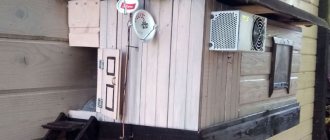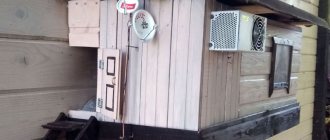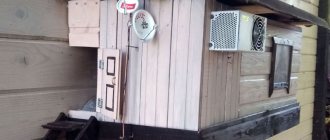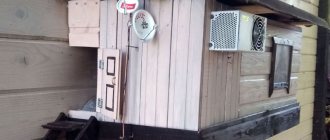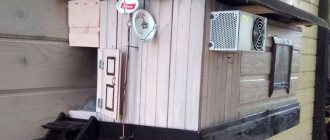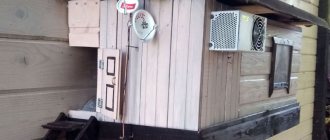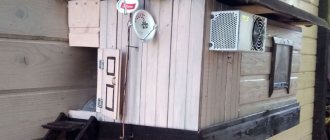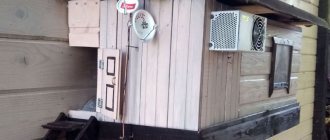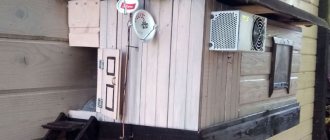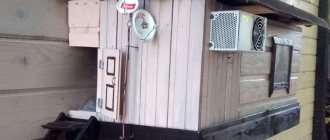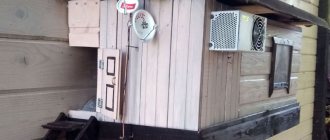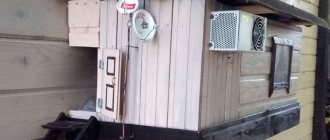Another homemade product for those who are bored at home
I needed a couple of antennas for digital, in places with “not the best reception”... I went shopping (this was before self-isolation - if it’s relatively budget-friendly, then it’s complete G. The more expensive one looks decent, but how it works is questionable.
- if it’s relatively budget-friendly, then it’s complete G. The more expensive one looks decent, but how it works is questionable.
I decided to make something homemade. It was somehow awkward to “twist” an antenna from a piece of cable (although rumor has it it works) - I wanted something simple, but more decent and advanced
In fact, the one I made is not radically more complicated, but somehow more “solid” or something. And the results of its testing were very encouraging, so I decided to sketch out a short description of what and how, in case someone else finds it useful 
... even if my street cats have a “normal” antenna on their house, what can you do without an antenna?!
The wire is not all finished yet, now we’ll assemble something!
In the places described, I previously used home-made broadband log-periodic antennas, probably since the “beginning of perestroika.” They worked well in analog and not only on UHF, but “for some reason, digital was too tough for them.” I didn’t really delve into the essence of the reasons, I removed them and began to think about what to replace them with. Here is one of them, waiting for a place in the trash
They worked well in analog and not only on UHF, but “for some reason, digital was too tough for them.” I didn’t really delve into the essence of the reasons, I removed them and began to think about what to replace them with. Here is one of them, waiting for a place in the trash
A little history
In the early 60s of the last century, our compatriot Kharchenko K.P. developed a simple flat zigzag antenna with good characteristics.
Copyright certificate No. 138277 for an invention called “Band directional antenna” was issued to Konstantin Pavlovich Kharchenko in 1961 (according to his application dated June 16, 1960). In the same year, materials were published in the magazine “Radio” for repetition by radio amateurs.
The antenna is not critical to materials and dimensions during manufacturing, has a simple good match with the reduction cable, and it successfully combines multiple elements of a common-mode antenna array with a single feed point.
Antenna options for digital signal reception
Reception of DWM waves can be carried out by many antennas. To display DVB-T2 digital television, the receiver can be constructed from only one cable, or from additional elements.
Each television receiver will have different characteristics. They must be taken into account when choosing, especially if you live far from the city where there are no TV towers nearby.
Below is a table of the most common TV antennas. They work best and are the easiest to manufacture.
| Type | Coef. gain, dB | Maximum signal reception range, km | Operating range, MHz | |
| Without amplifier | With gain | |||
| From cable | 0-3 | 15 | 15 | 440-800 |
| From cans | 3-5 | 15 | 40 | 470-622 |
| Butterfly | 5-11 | 20 | 70 | Any (needs calculations) |
| Triple square | 9 | 15 | 60 | |
| Kharchenko (or biquadrat) | 5-6 | 10 | 50 | |
| Log-periodic | 8-12 | 30 | 100 | |
There are more complex options. But despite all the difficulties in manufacturing, they have significant drawbacks. At the same time, the quality of reception is not so high compared to the table ones. Therefore, there is no point in doing them yourself. For example:
- Kovachev antenna;
- Turkina;
- wave channel.
Theory and calculations
The described antenna, in theory, has a horizontal “figure-of-eight” radiation pattern and a relatively high gain, which can be further increased by using a reflector/reflector.
To obtain maximum gain on all channels, it is necessary to make an antenna approximately in the middle of the range between the multiplexes used.
Finding (for calculations) the frequencies of multiplexes used in your region is easy,
for example, a request like “dvb-t2 channel frequencies” + “Krasnodar”
I found something like this:
The middle, between “my” two multiplexes, is 700 MHz - we will calculate the antenna at this frequency.
As a basis for calculating the dimensions of the antenna, we take the drawing of its author
Calculate the wavelength: λ = 300 / f [m]
300/700 = 0.428m, approximately 43cm length of each side of the rhombus
λ/4
=43/4= 10.75
The total length of the material we need (11cm*8=88cm) is less than a meter. The distance between the reduction contacts, where we will solder the cable, is 10-12mm (the standard value for this antenna for frequencies below 900 MHz).
I will make a simple antenna, without a reflector, however, to further increase the gain of this antenna, it is quite possible to install it behind it
for example, from a metal mesh/grill, foil material or simply a metal plate. Its dimensions should be approximately 20 percent larger than the dimensions of the antenna and it should be located at a distance of ƛmax/7. For my case: wavelength (channel 39) 300/618, it turns out...49/7= that is, about 7cm
For those who are too lazy to do the calculations themselves
— you can use an online calculator, the results will differ only slightly from those I received. Here, for example, this one - here you immediately enter the frequencies of two multiplexes and get the dimensions of the antenna (without a reflector) Or another option, with a reflector - I really want to note that in the second option a slightly different calculation option is used, different from the author’s. An antenna with angles other than 90° is assumed and the reflector distance is calculated as λ/8
To make the antenna sheet, it is recommended to use aluminum or copper (copper is easily soldered) with a diameter of 3 mm and higher - the larger the diameter, the more broadband the antenna is. You can use tubes; the thickness of the walls is not important, since only the surface of the material is used (in fact, you can wrap any dielectric with foil to obtain the required material). However, in my opinion, the easiest way is to buy a meter of large-gauge copper wire at an electrical supply store.
Antenna assembly
Let's remove the insulation from a piece of wire one meter long.
I got a wire with a diameter of 4.5mm
The tools you will need are a vice and a hammer. Measure approximately 11cm each and bend at an angle of 90°
The end result is to get such a “geometric” figure 
We cut off the excess and solder the ends. It should look something like this...
Solder the cable as shown in the photo.
We lay the cable along one side of the square and secure it with clamps. This arrangement of the cable is necessary for its coordination (there are different opinions, not everyone agrees with this statement).
When using a reflector, the antenna sheet at the extreme points of the squares can also be secured using metal stands, for example, soldered onto the remains of the same copper wire - there are points with zero potential (highlighted in green). In other places, fastening is allowed only through a dielectric.
Tests
And finally, a performance check and a rough
assessment of the quality of the resulting antenna.
In fact, everything is simple with the test - turn it on, it works! And to evaluate whether the game was “worth the candle,” let’s compare the parameters of the received signal from the manufactured antenna with the one I’m already using at the dacha, with a declared gain of 11dBi
And to evaluate whether the game was “worth the candle,” let’s compare the parameters of the received signal from the manufactured antenna with the one I’m already using at the dacha, with a declared gain of 11dBi
The antenna is installed in the attic of a country house, at a distance of approximately 16 km from the tower.
Signal level: factory stationary antenna on the left / homemade on the right
At first glance, the difference is only 1% (95 versus 94) - but this is not a completely correct comparison, since my external antenna is connected through a splitter, which further weakens the signal.
How to choose the right indoor television antennas?
When choosing an indoor antenna for digital TV, you should pay attention to:
- The ability to receive decimeter waves (UHF), that is, digital television, is a prerequisite.
- The ability to receive a DVB-TV2 signal, that is, the digital signal standard used by domestic “digital” broadcasts.
- Power source type – active or passive. The passive device is powered by a TV or set-top box, the active antenna is connected to a separate outlet and guarantees a more powerful signal.
- A signal booster is an important consideration if the location is remote from the tower. The presence of an amplifier is mandatory for country houses, dachas or the outskirts of the city.
- Amplifier power - if the location is remote from the television center, you need at least 30-40 dB.
- Reception of FM frequencies – makes it possible to listen to digital radio.
Before you buy an indoor antenna for receiving a digital TV signal, you should check the digital TV coverage area or determine the distance of the television center from your area of residence on the official RTRS website. This will determine whether it is necessary to have a built-in signal reception amplifier. And this review with reviews and rating characteristics will help answer the question of which indoor antenna is best to buy for a TV.
Assessing the performance of the antenna
Let's try to make a more correct comparison by connecting through the splitter input.
Well, in addition, for clarity, let’s add the number of participants List of antennas taking part in the comparison:
1. External antenna Funke BM 4551 external long-range,
declared gain, from some sources (bought at Yulmart), up to 16dB
2. There is an old UHF loop antenna, from TV Electronica 313d, I must say, despite its simplicity, it’s a very good antenna, that’s why it’s been preserved 
3. I went to the store and bought for comparison in the review one of the cheapest, such as a symmetrical vibrator (100% the most purchased by pensioners, due to the low price).
I will carry out all “measurements” at one point, located as close as possible to the external antenna - its location was experimentally selected based on the maximum signal, so we can say that the conditions are approximately the same
So, we have already seen the signal level from the external antenna at 95% (at the time of current measurements it showed 94%), we take it as a standard. All comparisons are made by connecting antennas to the input on the splitter, to which an external antenna is usually connected.
Loop antenna, from Electronics 82% on 39 multiplex and 66% on 60
Budget with “horns” - 62%/38% (on the verge of losing the broadcast)
- 62%/38% (on the verge of losing the broadcast)
Double square - 92% on both multiplexes, about a couple of percent less than the external one
Out of curiosity, I decided to check the work of the reflector, which is easy to make from any metal mesh, plate or even foil... It REALLY works noticeably! The level rose to 96%!, which is even higher than the stationary one, with a declared gain of 11dB.
The most interesting thing is the object that I used as a reflector! 
There was no foil in the house; the only thing available with a metal surface of the required size was... a laptop cover (I have a metal case). But the main thing is the result! It’s clear that I’m not going to “tie” the laptop to the antenna, and its amplification is enough for me without a reflector
TOP 5 outdoor TV antennas
Hyundai H-TAE220
This is a passive antenna without an amplifier; it receives a signal only due to its geometry, but does not require a separate power source. Very branched design, silver color, looks nice. The signal amplification is only 15 dB, which is logical for a passive model. The dimensions are so compact that they can be installed in a room, the length is only 40 cm. It is completed with a waterproof cap and accessories for installation.
Advantages:
- Does not require a separate power source.
- Compactness.
- Although it is passive, it receives the signal well.
- Easy installation.
- Can be installed in a room.
Flaw:
- Works only in the UHF range.
The antenna is very good, inexpensive, its price is 690 rubles. Although it is not equipped with an amplifier, it picks up the maximum number of channels with high quality. If you need an active antenna with about the same price, I recommend the Locus Meridian 07AF Turbo, we’ll talk about it later.
Reviews on Yandex.Market
Locus Meridian 07AF Turbo
Active, this series antennas are equipped with a patented balanced amplifier, which improves the signal-to-noise ratio by 3 dB when compared with conventional amplifiers. To put it simply, the reception range has been increased. The structure itself is made of aluminum. Please note that the power supply is not included in the kit; the manufacturer offers to buy the injector separately. Without it, the antenna works like a passive one, with low power and picture quality. I advise you to purchase more immediately if your TV does not have the function of supplying power to the antenna output. Price - 750 rubles.
Advantages:
- Powerful signal reception, catches at a distance of up to 50 km from the TV tower.
- Lightweight, compact, can be placed in the room.
- Comes with a patented amplifier.
Flaw:
- Does not come with a mounting bracket.
A good inexpensive antenna that has received a lot of positive user reviews. If you don’t want to bother with connecting the power, I recommend the previous sample from the review - Hyundai, but it will not provide such signal amplification or clear picture as the active model. One of its main advantages is that the aluminum structure is very light in weight and can be mounted almost anywhere.
Reviews on Yandex.Market
Selenga 112F-A
Antenna with low noise amplifier. Power is supplied from a USB injector, which is not included in the package, or from a 5V antenna socket. Unlike Locus, Meridian 07AF Turbo is equipped with fasteners, which is already a plus. Operates in UHF and VHF bands with a signal gain of 29 dB. Suitable for an area of reliable signal reception with a distance to a TV tower of no more than 40 km, so the reception range of Locus is slightly higher.
Advantages:
- Comes with fasteners.
- High picture quality in areas with reliable signal reception.
Flaw:
- Suitable only for areas with reliable signal reception.
The antenna is standard - in terms of signal amplification, power connection, operating range. The signal amplification is slightly higher in the HARPER ADVB-2440, but not significantly, and the Harper is strikingly different from the others in design, but we will discuss it in more detail later. It is advisable to choose it if you need FM reception. Overall, for 790 rubles it’s a good antenna and a decent choice. Nothing extra, just a high-quality picture. The downside is that the reception is uncertain in difficult conditions; it is optimal to use it in places with a strong signal.
Reviews on Yandex.Market
LUMAX DA2501A
The antenna's signal amplification is good - 30 dB, but only works in the UHF range. If you need more run-up, I recommend the HARPER ADVB-2440. The package includes a 5 m cable, but this is not a plus for all users, as it may be unnecessary and adds to the price.
Advantages:
- A 5m cable is included, although this may be a drawback for some.
- It picks up the signal well even in difficult conditions.
- Simple installation, low weight.
- Good mount (included).
Flaw:
- The package does not include a USB injector, but manufacturers do not include it, since it is not always needed.
The price of the antenna is similar to Selenga - 790 rubles, but unlike it, it can work not only in areas of reliable signal reception, but also in difficult conditions. The quality of the picture and reception is excellent, if you believe all the characteristics and customer reviews. Between Selenga and LUMAX, I would advise you to choose the second one. But Selenga operates in the VHF/UHF range, LUMAX in UHF. The signal amplification of LUMAX is greater, but not significant.
Reviews on Yandex.Market
HARPER ADVB-2440
The difference between this antenna and all others is immediately obvious - it is a fundamentally different design. It operates in the VHF/UHF/FM range, which also distinguishes it from other models as a plus. The signal gain is the highest - 30 dB, although the difference is negligible. Active amplifier. Another significant difference is that it supports not only DVB-T/T2 multiplexes, but also many others. Supplied with fasteners for installation on a vertical or horizontal plane.
The unusual spherical shape was not chosen by the manufacturer for the sake of beauty: now searching for the optimal direction to receive a signal is not required. This shape also reduces wind load. Power is connected via a separate adapter or adapter (included in delivery). The cable length is ridiculous - 1.5 m, and it is not always enough. I think it would be better to just not include it in the kit. Price - 1490 rubles.
Advantages:
- No need to adjust the antenna position, has a 360 degree view.
- Spherical shape means there is less chance that the antenna will be damaged by snow or strong winds.
- Supplied with fasteners and necessary connectors.
- Supports a large number of multiplexes, except DVB-T/T2.
- Can be installed on a vertical or horizontal surface.
- Good signal amplification, catches up to 50 km from the source.
- Compact size, can be installed indoors.
Flaws:
- The price is higher than competitors with similar characteristics.
- The fastener is not suitable for non-standard surfaces.
- Short wire included.
The antenna is more expensive than competitors, but worth the money. Its shape is attractive: you don’t have to worry that the wind will knock over either the antenna itself or its settings. Support for different multiplexes - but this may not be useful for everyone; most will be satisfied with DVB-T/T2. Works in a wide range, catches FM radio. According to user reviews, it catches well even in lowlands, at a great distance from the TV tower. If the price bothers you, take LUMAX or Locus, but the thing is good even for that kind of money.
Reviews on Yandex.Market
Conclusion:
I can confidently recommend repeating it!
Simple, “cheap and tasty”... One of the simplest, indoor antenna mounts... with ordinary suction cups - if you’re lucky with the direction to the television center
The next antenna "recommended for repetition" is... log periodic
“Crazy hands” were with you. Good luck and good mood to everyone! ☕
Good luck and good mood to everyone! ☕
